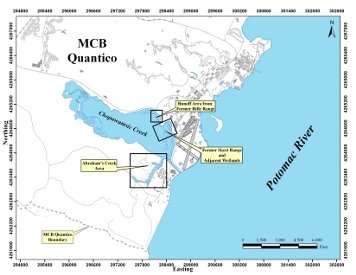quantico marine Corps base risk assessment
U.S. Navy
Site investigations for human health or ecological risk rarely consider conditions at the facility beyond the site footprint. Neptune’s innovation for the Naval Facilities Engineering Command (Washington) was to base decision making for the Potomac River sediments and sediments in the tributaries surrounding the Quantico Marine Corps Base on the corresponding watersheds for these areas. This allowed for a more comprehensive assessment of potential risk. Using this approach, factors such as other contaminated sites within the watershed, potential connecting mechanisms (e.g., surface water), and cumulative exposures across multiple sites influenced the risk assessment and management decision making. This approach relied on quantitative data quality objectives specifications, statistically based survey designs, and data interpretation. Uncertainties in the decision-making process were estimated for the site decision makers a priori in the survey design and quantitatively calculated for the site decision. This allowed decision makers to objectively assess the success of the implemented site investigation. This more comprehensive approach also introduced efficiencies in waste management and monitoring, making more cost-effective cleanup determinations and providing monitoring coverage with fewer sample locations while still ensuring acceptable risk protection. Monitoring for this project is ongoing.
Under this program, Neptune completed watershed level human health and ecological risk assessments, EE/CAs, feasibility studies, and long-term monitoring plans for sites where the primary contaminants have been lead, organochlorine pesticides, and PCBs. Specific watershed areas in the risk assessments included Quantico Embayment and the Potomac River adjacent to the Marine Corps Base, Abraham’s Creek, and tidal portions of Chopawamsic Creek and Quantico Creek. Neptune identified data gaps and uncertainties in existing risk assessments and developed strategies and work plans to resolve these gaps and lessen the influence of the uncertainties on the risk decision-making process. Highlights of this program included resolving complex technical issues and developing approaches jointly with the Navy, regulatory agencies, and stakeholders.
Within each of the watershed areas, Neptune developed risk assessments to evaluate multiple lines of evidence, including: sediment chemistry; bioaccumulation in plant, invertebrate, and fish tissue; food chain modeling; and amphipod toxicity testing using survival and growth endpoints. Data collection in most areas included soil, sediment, and biological tissue, as well as sediment toxicity bioassay tests, bioaccumulation bioassays, and characterization of baseline conditions for evaluating chemical constituent trends and risk reduction due to ameliorative actions taken to address historical chemical releases. The results have been used to evaluate the adequacy of past remedial actions, to identify risk-based cleanup goals and associated remedial footprints where further remedial action was needed, to support feasibility studies for remedial method selection, to provide a basis for monitoring contaminant change during post-remediation time frames, and to address the current fishing restrictions for the protection of human health at the site.


